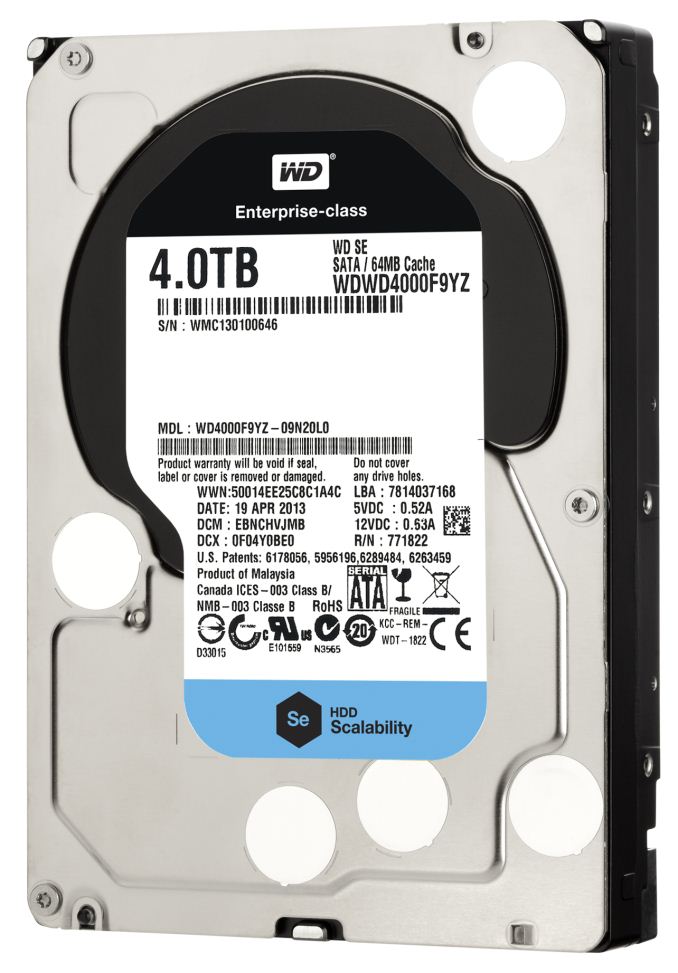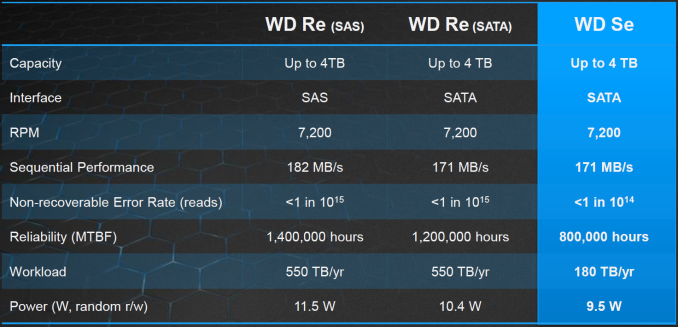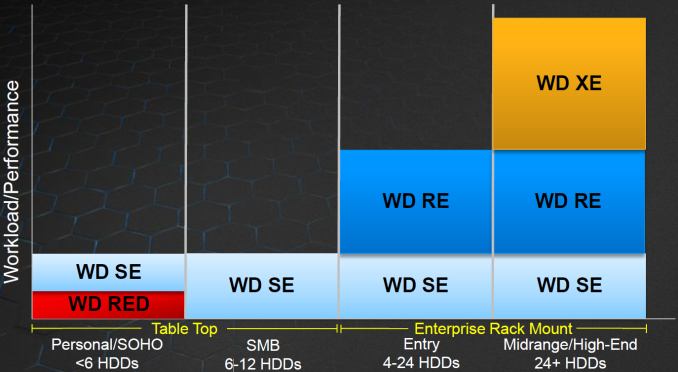Western Digital Launches WD Se Hard Drive Lineup for Datacenters and High-end NAS Units
by Ganesh T S on May 28, 2013 8:00 AM EST- Posted in
- HDDs
- NAS
- Western Digital
- Datacenter
- Enterprise
One of the most interesting launches from Western Digital last year was the WD Red line of hard drives from the client storage division. It was intended for low to mid-range NAS units (and WD wanted to make sure that it wasn't used for units with more than 5 bays). Today, the Datacenter Storage Business Unit is launching the WD Se line intended for high end NAS units and, more importantly, datacenters looking for scalable storage (i.e, reliable storage which doesn't cost an arm and a leg for scenarios where capacity, rather than performance, is of primary importance).
The WD Se line consists of 3.5" 7200rpm Advanced Format SATA drives in 2 TB (WD2000F9YZ), 3 TB (WD3000F9YZ) and 4 TB (WD4000F9YZ) capacities. All of these units have a 64 MB buffer. Pricing ranging from $160 at the low end to $310 at the higher end. Like the WD Re (and, unlike the desktop variants), the WD Se line has a self-encryption option. These drives come with the five year enterprise warranty. Western Digital touts the usage of WD Se drives in their own datacenter (with Apache Hadoop).
WD also advocates use of the WD Se drives in NAS units with 6 to 24 bays in both the desktop as well as rackmount form factors as a complement to the WD Red drives in the lower end units. In the datacenter, WD suggests usage of the WD Re and WD Xe drives for higher durability and performance. Note that the suggested workload for the WD Se is only 180 TB/yr, compared to 550 TB/yr for the WD Re, suggesting that WD is positioning this drive as a solution for backups, archiving and other low intensity tasks. On a comparative basis, the WD Red apparently has a workload rating of less than 100 TB/yr (the client storage division doesn't give out specific numbers) despite coming with a higher MTBF rating (1M hours compared to the 800K for the WD Se).
Some of the features of WD Se include dual processors to maximize performance, RAFF (rotary acceleration feed forward) to monitor and correct vibrations in real time (an issue common in datacenter environments), dual actuator technology to improve positional accuracy of the heads, StableTrac motor shaft securing at both ends to minimize vibrations, multi-axis shocks sensors, RAID-specific TLER (which we covered in the WD Red review) and dynamic fly height technology.













23 Comments
View All Comments
Jeff7181 - Tuesday, May 28, 2013 - link
Wow, that's quite a small segment of the market they're targeting with this. I wonder if these are just RE's that didn't pass QA. We've all heard of CPU binning... maybe they're binning HDD's...bobbozzo - Tuesday, May 28, 2013 - link
Since these are for 'datacenter NAS' use; I'm guessing they as good as or better than the RE's.Gigaplex - Tuesday, May 28, 2013 - link
Given they're quoted with a lower workrate and MTBF rating than the REs I doubt they're better.joel4565 - Tuesday, May 28, 2013 - link
Ganesh T S,What is wrong with using the Red series in larger filer servers? I see your comment in the article "WD wanted to make sure that it wasn't used for units with more than 5 bays"
I thought WD's Red series were extremely popular in FreeNAS and Unraid boxes. And those boxes often have more than 5 drives. Is there an inherent problem with using the Red series in a larger array?
I currently have a 10 drive Unraid setup build with WD green series, but I am thinking of migrating to FreeNAS next year and building a RaidZ2 array with 8-10 drives and was planning on using WD red drives. If the price difference is not much for SE over Red, I will get SE drives, but I have a feeling there will be a 50-100 difference per drive.
Jeff7181 - Tuesday, May 28, 2013 - link
"And those boxes often have more than 5 drives." They do? I think the majority of home NAS setups are the 2-3 disk setups people buy off the shelf at Best Buy. Not a 8-10 disk home built FreeNAS box.joel4565 - Tuesday, May 28, 2013 - link
I didn't mean that most of Red drives are used in FreeNAS or Unraid boxes. I am aware that most people who buy Red drives would be using them in some like a Buffalo, drobo, etc box that holds 2-5 drives.I meant that many people who make FreeNAS or Unraid boxes would consider using WD Red drives. I know many Unraid users used WD green drives, before the Red series existed.
mfenn - Tuesday, May 28, 2013 - link
WD wanted to make sure that the Red drives didn't cannibalize sales of their RE (and now SE) drives. Thus the arbitrary NAS slot limitation. They have that sort of leverage over NAS makers because they can withhold discounts, limit quantities, and other various tricks.Are such practices anti-competitive? You betcha.
Does that stop WD? Nope.
garcondebanane - Tuesday, January 7, 2014 - link
How exactly is this practice anti-competitive?watersb - Tuesday, May 28, 2013 - link
I have 10 WD Red 2TB in a ZFS array for the home office. I am very interested in more storage coverage.roberta - Tuesday, May 28, 2013 - link
@joel4565The problem(s) are vibrations from the HDDs themselves.